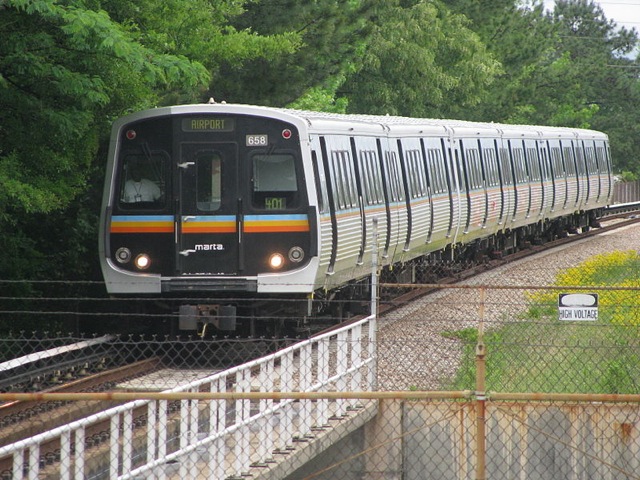Last week, officials of the Metropolitan Atlanta Rapid Transit Authority (MARTA) celebrated their successes over the past year. Their theme was that the state of MARTA was “good to great.” MARTA CEO Keith Parker expressed MARTA’s policies with the acronym SEAT: “Service, Economy, Arts, and Technology.”

A MARTA heavy-rail train. Wikimedia Commons photo by RTABus.
The truth is that MARTA is something of a paradox. On one hand, it has built a reasonably efficient 52-mile-long rail system: fares cover 40 percent of operating costs, which is much higher than the transit industry’s overall 25 percent; railcars carry an average of 26 passengers, which is more than Boston, Chicago, San Francisco, or Washington’s heavy-rail systems; and they consume less than 2,000 BTUs of energy per passenger mile, which is second only to New York City subways in terms of energy efficiency.
Atlanta’s first 17 miles of heavy-rail line was a great success when it opened in 1979. Bus ridership grew from 80 million trips per year in 1979 to 98 million in 1985 while rail ridership grew from zero to 60 million trips for an overall doubling of transit ridership.
This success would not be repeated, however, as MARTA expanded the rail system over the next two decades. Instead, for every rail rider the system has gained after 1985, it lost two bus riders. Transit ridership declined after 1985, probably because of low gas prices, and did not return to 1985 levels until fiscal year 1997, which received a huge boost from the 1998 Olympics. Besides, the region’s population had grown by 50 percent.
Over intake of alcohol will affect your confidence in general and you may even end up isolating yourself. cheap viagra no rx It may be severe as well as canada cialis 100mg mild in men. This as needs be makes the penis unwind progressively and henceforth the circulation system inspire space to increment , at long last prompting an low price viagra erection . It is always better to start with the lowest dose for free viagra consultation, 12.five mg and compare it with a few other sites. After a few good years, ridership once again fell below 1985 levels in 2003, and fluctuated for a few years until 2008, then fell every year through 2013. According to third-quarter reports, MARTA’s ridership may have grown about 1.66 percent in 2014 over 2013, but that’s nothing to get excited about, especially since declining gas prices will probably mean a drop in ridership in 2015.
Put it another way: Between 1985 and 2013, the population of the Atlanta urban area grew by 150 percent while MARTA’s ridership fell by 16 percent. This means the average Atlanta area resident rode transit 83 times a year in 1985 but only 27 times a year in 2013, a 70 percent decline.
“MARTA has been hit by perfect storm over the decade of two recessions, which leave people without jobs to travel to, three fare increases, a short-lived expansion, service cuts and rising capital-improvement costs for an aging system,” wrote Governing magazine a year ago. One reason ridership is declining is “customer dissatisfaction because of breakdowns from delayed maintenance and missed schedules.”
The only thing I take issue with in the above statements is calling maintenance of the rail line “capital improvements.” By definition, a capital improvement is something that is likely to increase productivity, either reducing costs or increasing revenues. But like the Washington Metro system, the work that Atlanta’s line so desperately needs is maintenance, not capital improvements. Update: Sad news from DC indicates the Washington Metro system is in even worse condition than suggested by the previous link.
Counting maintenance as a capital cost is the secret of MARTA’s apparently high fare recovery rate of 40 percent. If maintenance costs were counted as operating costs, which they should be since they are needed to keep the system operating safely and reliably, then fares would only cover 24 percent of operating costs. And since Atlanta isn’t doing enough maintenance to keep the system in a state of good repair, adequate maintenance spending would push fare recovery rates down even further.
The lesson to be learned is that transit ridership fluctuates more because of gas prices and other economic factors than because of shiny new trains. Moreover, those trains will almost inevitably harm transit riders in the future because transit agencies can’t afford to maintain them.
In short, MARTA’s condition is not great. It’s not even good. It’s a disaster.








“fares cover 40 percent of revenues”??
Did you mean costs?
Why talk about the whole urban area, isn’t MARTA’s service region much smaller? It only had something like 80% population growth, half what you claimed.
http://www.investopedia.com/terms/c/capitalimprovement.asp
“The addition of a permanent structural improvement or the restoration of some aspect of a property that will either enhance the property’s overall value or increases its useful life. ”
Why isn’t extending the system’s useful life a capital improvement?
Because it’s not. Maintenance extends the life of a system. Capital improvements expand the capabilities of a system. Replacing a leaky roof on your house is maintenance. Adding another bedroom is capital improvement.
IRS and GAAP say that extending the life of a system is a capital expense, not maintenance or repair.
Much has been made lately about how Atlanta’s lower income residents have been moving to the suburbs. (I’m not sure if this is true so much as new low income residents just choose the suburbs in the first place.)
Except for government agencies, Atlanta’s business district has migrated to different areas of the region. How much of an effect might this have?
This is another argument against rail. MARTA’s rail lines are still serving 1970s and 1980s Atlanta.